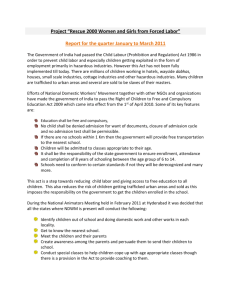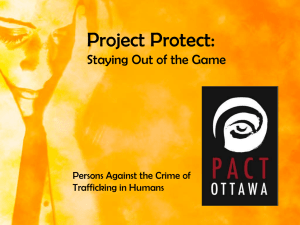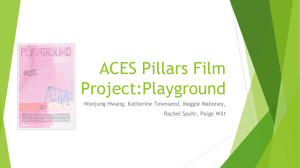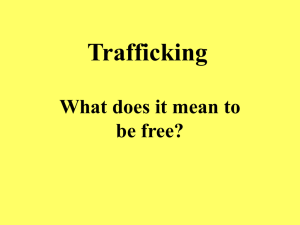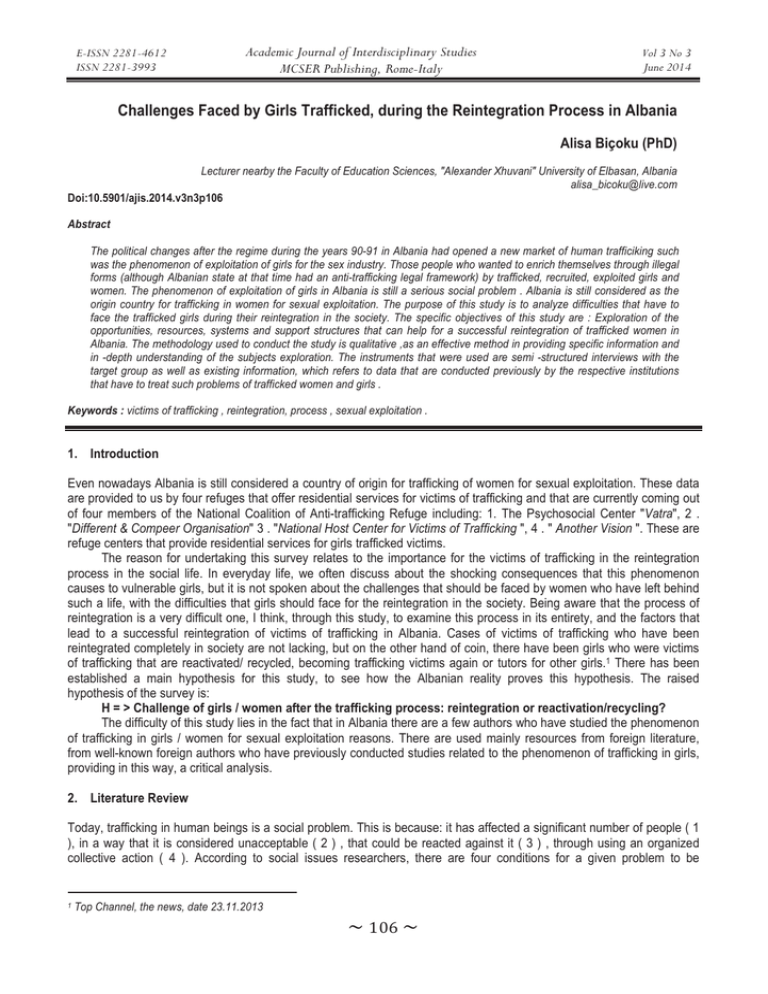
E-ISSN 2281-4612
ISSN 2281-3993
Academic Journal of Interdisciplinary Studies
MCSER Publishing, Rome-Italy
Vol 3 No 3
June 2014
Challenges Faced by Girls Trafficked, during the Reintegration Process in Albania
Alisa Biçoku (PhD)
Lecturer nearby the Faculty of Education Sciences, "Alexander Xhuvani" University of Elbasan, Albania
alisa_bicoku@live.com
Doi:10.5901/ajis.2014.v3n3p106
Abstract
The political changes after the regime during the years 90-91 in Albania had opened a new market of human trafficiking such
was the phenomenon of exploitation of girls for the sex industry. Those people who wanted to enrich themselves through illegal
forms (although Albanian state at that time had an anti-trafficking legal framework) by trafficked, recruited, exploited girls and
women. The phenomenon of exploitation of girls in Albania is still a serious social problem . Albania is still considered as the
origin country for trafficking in women for sexual exploitation. The purpose of this study is to analyze difficulties that have to
face the trafficked girls during their reintegration in the society. The specific objectives of this study are : Exploration of the
opportunities, resources, systems and support structures that can help for a successful reintegration of trafficked women in
Albania. The methodology used to conduct the study is qualitative ,as an effective method in providing specific information and
in -depth understanding of the subjects exploration. The instruments that were used are semi -structured interviews with the
target group as well as existing information, which refers to data that are conducted previously by the respective institutions
that have to treat such problems of trafficked women and girls .
Keywords : victims of trafficking , reintegration, process , sexual exploitation .
1. Introduction
Even nowadays Albania is still considered a country of origin for trafficking of women for sexual exploitation. These data
are provided to us by four refuges that offer residential services for victims of trafficking and that are currently coming out
of four members of the National Coalition of Anti-trafficking Refuge including: 1. The Psychosocial Center "Vatra", 2 .
"Different & Compeer Organisation" 3 . "National Host Center for Victims of Trafficking ", 4 . " Another Vision ". These are
refuge centers that provide residential services for girls trafficked victims.
The reason for undertaking this survey relates to the importance for the victims of trafficking in the reintegration
process in the social life. In everyday life, we often discuss about the shocking consequences that this phenomenon
causes to vulnerable girls, but it is not spoken about the challenges that should be faced by women who have left behind
such a life, with the difficulties that girls should face for the reintegration in the society. Being aware that the process of
reintegration is a very difficult one, I think, through this study, to examine this process in its entirety, and the factors that
lead to a successful reintegration of victims of trafficking in Albania. Cases of victims of trafficking who have been
reintegrated completely in society are not lacking, but on the other hand of coin, there have been girls who were victims
of trafficking that are reactivated/ recycled, becoming trafficking victims again or tutors for other girls.1 There has been
established a main hypothesis for this study, to see how the Albanian reality proves this hypothesis. The raised
hypothesis of the survey is:
H = > Challenge of girls / women after the trafficking process: reintegration or reactivation/recycling?
The difficulty of this study lies in the fact that in Albania there are a few authors who have studied the phenomenon
of trafficking in girls / women for sexual exploitation reasons. There are used mainly resources from foreign literature,
from well-known foreign authors who have previously conducted studies related to the phenomenon of trafficking in girls,
providing in this way, a critical analysis.
2. Literature Review
Today, trafficking in human beings is a social problem. This is because: it has affected a significant number of people ( 1
), in a way that it is considered unacceptable ( 2 ) , that could be reacted against it ( 3 ) , through using an organized
collective action ( 4 ). According to social issues researchers, there are four conditions for a given problem to be
1
Top Channel, the news, date 23.11.2013
̱ͳͲ̱
E-ISSN 2281-4612
ISSN 2281-3993
Academic Journal of Interdisciplinary Studies
MCSER Publishing, Rome-Italy
Vol 3 No 3
June 2014
classified as ' social2 .. Drawing a comparing between this definition of social problems, and that of trafficking, it turns out
that human trafficking has not always been a social problem.
Throughout the history there have been periods in which, for instance, to be a slave, was just ' normal ' as to be a
slaveholder. People are also used as 'cannon fodder ', for many things: from the battlefield to the bed. Trafficking has
become a social problem in the later stages of development of society, at the time of demolition of the slavery in general,
and then, at the stages of civilization and enlightenment, of the transformation of freedom into a universal human
aspiration, especially with coming out of the rule of law, with emphasis on fundamental human rights , etc. The reaction to
trafficking took the features of an organized collective action, especially during the twentieth century, with the foundation
of the international institutions, like the League of Nations ( later the UN ), or the European ones ( Council of Europe , EU
,etc. .)after World War II,3 not to go further. Of all forms of trafficking, the one for sexual exploitation is the most common
and the most intensively surveyed. We can draw conclusions from it, directly or indirectly, on the trafficking in general. On
one hand, it is accepted, almost unanimously, that prostitution is the "oldest profession in the world"4 . On the other hand,
it has been proven that voluntary prostitutes have never sufficed to ' saturate ' its market. Recruitment through trafficking,
is just the response to this requirement.5
Human trafficking is a major problem in Europe. International Labour Organization (ILO) estimates that there are
more than 2,45 people trafficked in Europe , mostly women and children.6
Trafficking in women for sexual exploitation is a considerable part of this traffic. According to an estimation by the
National Review7 tens of thousands Russian women and girls migrate every year by supplying the market of prostitution
in Western countries.
3. The Evolution of the History of Trafficking in Albania
While trafficking in Albania for prostitution purposes or exploitation for profit-making, "has no history ". At least, it is not at
all a typical Albanian phenomenon.8 There is not any evidence that trafficking of girls have existed in the first half of the
twentieth century, the time when it is attested the spread of prostitution in Albania, and even its legalization (between the
years 1920-1944 )9 estimated at the time, as a measure for the protection of public health and morality.
The archival documents10 show that in Albania, during this period, the girls practiced the sex worker profession
with their own desire and "free- will ".11 Setting dictatorial regime in Albania ceased the era of prostitution organized
during that period (1944 - 1945), because trafficking was considered part of the class struggle and the prostitutes as "the
thrown away from the Society"12
In Albania, women trafficking began after 1990, in the conditions of lack of a legal framework on anti-trafficking.
The first law on trafficking was approved in 1995.13
The trafficking data in Albania are quite contradictory. According to the official data, referring to denunciations of
the family members, more than 600 Albanian women result still missing.14
It is asserted that only Western Europe has more than 30 thousand Albanian prostitutes, not to mention other
countries.15
Horton B. Paul, Leslie R.Gerald, Larson F. Larson. The Sociology of Social Problems, New Jersey:Printice-hall,1991
In fact, Albania has acceded to the International Convention for the elimination of trafficking of women and children, before World War
II, back in October of 1937
4 Bryan,1968: p. 257
5 Sokoli, Lekë.2005b. The Professional Prostitution in Albania and debates about the assessment "Prostitution is a typical Albanian
phenomenon". "The Human rights"- magazine. No. 2
6 The quotation is taken from the Council of Europe: The Convention on trafficking human beings. Tirana, 2006, p.5
7 According to National Review, January 2003, http://nationalreview.com. This is the sequence that the sociologist Onnie Wilson herself
has made (2003)
8 Sokol, Lekë.2005b. The professional Prostitution in Albania and debates about the assessment " prostitution is a typical Alabanian
phenomenon". “The Human rights “-magazine. No. 2 (42), pp. 55-72.
9 Legalization of prostitution based on government decision No. 196, dated February 10, 1922, which approved rules of prostitution. After
its approval in the Parliament, this regulation became law. (Official Gazette, No. 30, August 1922, p. 4.
10 Sokol, Lekë.2006a (The father and the trafficked daughter) 2006, (Integration and traditional morality)
11 Sokoli, Lekë.2006, Trafficking, The case in Alabania, p.22.
12 Alia, Ramiz. 1986, p.153
13 Criminal Code of the Republic of Albania (CPC). Tirana: Publication of the Official Publications Center
14 Hoxha, Edmond. 2005.Than women missing in Albania.’ Metropol’ Newspaper, July 21
15 Çupi, Alma. 2001. Prostitution, ‘an endless epidemics.’ Albania’ newspaper: April 18
2
3
̱ͳͲ̱
E-ISSN 2281-4612
ISSN 2281-3993
Academic Journal of Interdisciplinary Studies
MCSER Publishing, Rome-Italy
Vol 3 No 3
June 2014
However, I would point out the fact that in the Albanian society, there are no more cases of those girls who
exercised sex-worker profession in countries outside the Albanian territory and once identified by police, they have been
extradited from neighboring countries and turned back either to their families (in rare cases, due to the stereotypes and
prejudices that they had on trafficked victims), or they were assisted in residential centers that provided services to them.
Actually, the internal trafficking is widespread in Albania; girls that practice the sex- worker profession by their traffickers
within the Albanian territory. Such cases are more difficult to be identified by the Police (Anti-trafficking Department). In
order to carry out this survey more efficiently, I have raised a set of research questions such as: - Are the trafficked girls
supported by their family of origin? (stereotypes and prejudices they face in their family and community ) - Trafficking of
girls / women, an irreversible process or otherwise, how can we get out of this situation? - What is the challenge of girls /
women after the trafficking process: Reintegration or reactivation/recycling? – What is the attitude hold by the families
and the society towards the girls after trafficking process?
The shelters that deal with the victims of trafficking in Albania face with many difficulties in the process of
reintegration of girls, victims of trafficking, as the process of reintegration itself, according to Surtees, refers to "the
process of improving the situation as well as social - economic involvement after a trafficking experience. This process is
costly not only financially, but it is complex and influenced by a number of personal factors and other broader social,
cultural and economic factors"16
If you provide a definition for the reintegration process of VOT I would say that:
Reintegration refers to the process of recovery and social –economic involvement of the individual after a
trafficking experience. Reintegration involves placement in a safe environment, access to reasonable living standards of
living, opportunities for personal economic development, as well as access to emotional and social support. In many
cases, reintegration includes the return of the victim in their families / community of origin. However, it may also include
integration into a new place, depending on the needs and interests of the victim.17
4. About the Methodology Applied
This study is entirely qualitative, as an effective method in providing specific information and profound understanding in
exploring the subjects.
I initially used, an extensive bibliography of studies, monographs, scientific articles or from the daily press, from the
Albanian and foreign authors, who have previously written for human trafficking.
The methods used in this study include analysis of primary and secondary data.
5. The Primary Data Refer to
•
Semi-structured interviews (with a focus group of 10 girls) which I have conducted with victims of trafficking,
re/integrated or in the process of reintegration.
Regarding semi-structured interviews, they contain closed and opened questions and personal narratives of
victims of trafficking.
For the preparation of the interview questions I have reviewed and taken into account a number of strategic
documents related to the issue of trafficking, and I have taken into consideration ten guiding principles with regard to
ethical issues of interviewing victims of trafficking.18
Taking into consideration that trafficking victims are regarded as "vulnerable" groups, they are ensured not to be
exposed to any danger.
6. The Justification of the Used Methodology
Reintegration of victims of trafficking exploited within the territory Albania, is a challenge of this study. Albania, being a
"small country ", the main problem is that trafficked victim girls are recognized by the people of their towns, who label
them as "prostitutes ", and this fact hinders their involvement in social life. Therefore, the method that I have necessarily
Surtees, Rebecca. 2008. Re/integration of trafficked persons: how can our work be more effective, NEXUS Institute.
(Surtees, 2008) 6 Surtees, Rebecca. 2008. Re/integration of trafficked persons: how can our work be more effective. NEXUS Institute
(2003). WHO ethical and safety recommendations for interviewing trafficked women. London School of Hygiene and Tropical Medicine,
London: Daphne Program of the EU.
16
17
̱ͳͲͺ̱
E-ISSN 2281-4612
ISSN 2281-3993
Academic Journal of Interdisciplinary Studies
MCSER Publishing, Rome-Italy
Vol 3 No 3
June 2014
applied in this survey is the qualitative method, as an effective method in providing specific information and deepened
understanding in exploring the subjects. Regarding this phenomenon, the collection and analysis of data could be
accomplished efficiently using semi- structured interviews, thus giving the opportunity to the interviewee to talk about a
number of issues on their own way.
7. The Measuring Instrument
In this study, the compilation of instruments is conducted by relying on the work of Holstein and Gubrium (1995). There
are used "semi- structured interviews ", which do not focus on structured questions but in techniques. There are included
two elements in the interviews, objective and subjective, and such interviews are directed with easiness. The subjective
element consists in how the interviewer will interpret "what the interviewers want and have got the opportunity to develop
their own opinion based on this perception, which can also be wrong." Objective elements are mainly related to the
zealous discussion realized between the interviewees and the Interviewers.
8. The Survey Outcomes
Since part of the research methodology is the focus group, thus this study is focused on the implementation of ten
interviews with victims of trafficked girls, that have been assisted previously at the residential center "The New Moon ", in
Elbasan –Alabania, and currently leading an independent life.
According to the data analysis, carried out through SPSS program for the demographic section of the
questionnaire, the following data resulted:
8.1 Age
The interviews conducted with victims of trafficking show that their age is from 15 to 38 years old. Of these, one trafficked
girl is at the age of 15 to 20 years old, the largest number of trafficked girls are at the age of 20-25 years old (six), two
girls belong to the age of 30-35 years old and one girl belongs to the age 38 years old .
8.2 Level of Education
The education level of the victims of trafficking is mostly that of primary school graduates; five of the trafficked girls turn
out to have completed it, two of the girls have not completed the primary education. Meanwhile, one victim girl has
completed the secondary school, one victim girl of trafficking is attending the secondary school (part-time) and one victim
girl of trafficking has not attended any primary education (she is illiterate)
8.3 Marital Status
From the interviews, it comes out that the legal marital status of the most of the interviewees are seven girls are ' single ';
three trafficked victims are currently married.
8.4 Birthplace and Origin
The birthplace of the victims has a wide geographical distribution and to better facilitate the interpretation, I have divided it
into three provinces: Northern regions, provinces in central Albania, and southern provinces. More specifically, six
interviewed victims were from the southern region of Albania, three victims belong to the middle region of Albania and
one trafficked girl belongs to the Northern areas. It is evident that the smallest number of cases of trafficked girls is the
Northern regions of Albania, probably because of the traditionally conservative, patriarchal, isolated mentality
characterizing this province.
9. Interview Questions
The second part of the questionnaire was compiled for the difficulties encountered by girls after reintegration process
(independent living ). To the question "What are the difficulties faced by trafficked girls after reintegration process"?
Out of ten victims interviewed, eight girls identified as a primary difficulty finding a job, one girl was working as a
̱ͳͲͻ̱
E-ISSN 2281-4612
ISSN 2281-3993
Academic Journal of Interdisciplinary Studies
MCSER Publishing, Rome-Italy
Vol 3 No 3
June 2014
secretary in a enterprise in the country of Italy, one trafficked victim girl was physically unable to work because she
suffered from a mental disease.
Regarding the question " If they were supported by the family of origin ", out of the ten girls interviewed, it comes
out that: five of them have no contact with the family of origin since when they were trafficked, because they do not want
to have direct contact with their daughters; two girls keep contacts with their families, and three VOT are reintegrated in
their families.
Concerning the question " If they so feel fully reintegrated ", out of ten girls interviewed it resulted: one girl VOT is
fully reintegrated outside the Albanian territory ( Italy ), where she currently has a satisfactory job ( secretary in enterprise
), she has created her own family, leaving behind negative experiences she suffered during her previous life; three girls
were reintegrated in a city of Albania, where one of the girls was working in a tailoring company, one girl working as a
hairdresser and one girl working as cleaner in a bar; but one of the major challenges faced by them was the economic
hardship to survive with the income that they earned with their job. one girl returned to the family of origin, in a commune
of the city of Korça, but she did not classify herself as a person leading an independent life, for this girl was not working
and stayed isolated in her house ; one girl was reintegrated into the family of origin and attended the high school; one girl
was reintegrated in her family of origin and suffered from mental problems, who found it impossible to get hired and to
create an independent living, three girls confirmed that they are reactivated again exercising the profession of sex
worker.
Concerning the question " What are the factors that have influenced their reactivation/recycling”: The three girls
confirmed that they were reactivated again for they were not able to find a job and keep it; the financial difficulties
resulting from the unemployment and lack of education to find a job.
10. Conclusions and Recommendations
I think and that there are a series of factors that influence the process of reintegration of trafficked girls and make it
difficult to be carried out in the Albanian society. The failure to carry out with proper efficiency the process of reintegration
into society of the trafficked girls is primarily related to the political, social- economic, demographic, moral and family
transformations, etc. , occurring in the recent 22-23 years.
Based on the interviews with the victims of trafficking, I assessed that it is important to identify the key elements
that would lead a trafficked victim towards a successful re/integration process as:
1.
Compilation of social policies to come to the aid of victims of trafficking as far as employment is concerned,
since it is regarded as one of the primary factors for a successful reintegration.
2.
Central /local government must help the victims for their accommodation by reducing the cost of their
residence.
3.
District Education Departments should create opportunities for the education of this group (free education).
4.
Enforce laws, national strategy against human trafficking, against traffickers.
5.
To financially reimburse VOT by the traffickers, so that they would commence a normal life.
6.
Accessing free health service, education and free legal aid to them.
References
Çupi, Alma. 2001. Prostitution, ‘an endless epidemics.’ Albania’ newspaper: April 18
Criminal Code of the Republic of Albania (CPC). Tirana: Publication of the Official Publications Center
Horton B. Paul, Leslie R.Gerald, Larson F. Larson. The Sociology of Social Problems, New Jersey:Printice-hall,1991
Hoxha, Edmond. 2005.Than women missing in Albania.’ Metropol’ Newspaper, July 21
Sokoli, Lekë.2006, Trafficking, The case in Albania.
Sokoli, Lekë.2005b. The Professional Prostitution in Albania and debates about the assessment "Prostitution is a typical Albanian
phenomenon". "The Human rights"- magazine. No. 2
Sokol, Lekë.2006a . The father and the trafficked daughter. Albania.
Sokol, Lekë.2006. Integration and traditional, morality`Albania
Surtees, Rebecca. 2008. Re/integration of trafficked persons: how can our work be more effective, NEXUS Institute.
Legalization of prostitution based on government decision No. 196, dated February 10, 1922, which approved rules of prostitution. After
its approval in the Parliament, this regulation became law. (Official Gazette, No. 30, August 1922.
The quotation is taken from the Council of Europe: The Convention on trafficking human beings. Tirana, 2006.
In fact, Albania has acceded to the International Convention for the elimination of trafficking of women and children, before World War II,
back in October of 1937
̱ͳͳͲ̱


